Top News
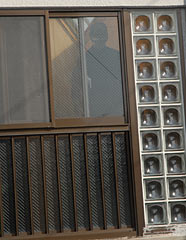
November 19, 2012 Ryukyu Shimpo
On November 18, the Naha Police arrested a 24 year-old U.S. Marine Corps lieutenant, who is based at Futenma Air Station, on suspicion of trespassing in a room of a building in Makishi, Naha. According to the police, the suspect denied the charges, claiming that a Japanese woman he met at a club told him to take a rest there. No particular damage resulting in injury has been reported. The police are investigating the suspect with regard to his motivation and behavior before the crime. The incident occurred in the early hours of the morning and alcohol was detected on his breath. The Marine Corps lieutenant seems to be guilty of drinking in a local off-base area during the middle of the night, thereby breaking the 11:00pm to 5:00am curfew placed on all U.S. troops in Japan.
U.S. Forces Japan imposed the curfew on all U.S. personnel in Japan after a sexual assault by two sailors occurred in the central part of the main island in October. However, on November 2, a heavily intoxicated airman from Kadena Air Base broke into a house and punched a junior high-school boy during the curfew. The effectiveness of curfew is now increasingly being questioned by people of Okinawa, and in the context of the deployment of the Osprey aircraft being forced upon Okinawa, the recent spate of incidents by U.S. troops is likely to inflame the Okinawan people’s opposition to the U.S. military.
According to the police, the Marine Corps lieutenant was arrested on suspicion of trespassing in the room on the top floor of four-storey building at 7:30am on November 18. While of the 30 year-old male restaurant employee was out he received a call from his acquaintance to the effect that “an unknown foreigner is asleep in your room.” He immediately called the police. Neither he nor his friend are acquainted with the suspect. According to the police, the suspect climbed up the outside stairs of the building, before entering the room through an unlocked front door and went to sleep in the bedroom. The suspect told the police that he drank alone at a few bars and restaurants in the city, in the evening of November 17.
A senior Foreign Ministry official revealed that on that same day, through the U.S. Embassy in Japan, the Japanese government asked the U.S. government to prevent any recurrence of incidents and to strictly enforce the law.
(English translation by T&CT, Mark Ealey)
Go to Japanese
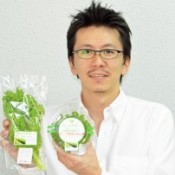
November 11, 2012 Maki Nagamine of Ryukyu Shimpo
Before the end of this fiscal year, Internationally Local & Company (InLo&Co), which operates a vegetable growing facility in which the temperature and levels of light are strictly controlled, will build a new facility in Itoman. The company is also planning to expand its existing facilities, and aims to more than double its growing area and its production level. InLo&Co’s sales target for the 2013 fiscal year is 50 million yen. It currently ships its products to high-class foreign clients, and is also considering building a new factory overseas by 2015.
In 2010 InLo&Co became the first company in Okinawa to operate a commercial plant growing facility and has been growing twelve kinds of vegetables such as iceplant, mesclun, and wasabi.
The current facility has a growing area of 100 square meters, to which InLo&Co will add a further 50 square meters and also will create approximately 100 square meters in a new facility.
While InLo&Co currently ships 70 to 80 percent of its products to supermarkets and restaurants within Okinawa, it also has gradually made inroads to the markets in the Kanto and Kansai areas, as well as overseas locations such as Hong Kong. InLo&Co currently ships iceplants to six restaurants in Hong Kong, and having carried out fact-findings missions to Singapore twice, it is now considering shipping there.
Yasuhito Sasaki, the president of InLo&Co said, “Our initial priority is to meet local demand in Okinawa and establish a business model. Then, we would like to offer our production know-how to other farmers.” He hopes to help local farmers, who are currently susceptible to the adverse effects of typhoons, to stabilize their income.
InLo&Co also carries out a “sampling and sales” event once a week at a local supermarket. Sasaki emphasizes, “We would like to see widespread use of vegetables grown in a safe plant growing facility. If we expand the market for such produce, it will help to provide farmers to achieve a stable income.”
Meanwhile, setting the goal of “creating a delightful and healthy world,” the company aims to create a growing facility in Hong Kong. They have high hopes that there will be a demand among wealthy customers for relatively expensive vegetables produced in the facility.
(English translation by T&CT, Megumi Chibana and Mark Ealey)
Go to Japanese
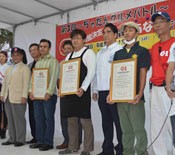
November 12, 2012 Ryukyu Shimpo
On November 11, the final of the 3rd C-1 Chatan Gourmet Battle was held in the square in front of the Chatan Park Baseball Stadium. Sponsored by the Chatan Tourism Association and co-sponsored by Ryukyu Shimpo, 30 food and beverage stores and outlets located in Chatan pit their new meal items against each other in a gourmet contest. Voting by the visitors to the event saw the Ishigaki Beef Hamburger from the Cafe Restaurant & Bar Doubledecker win the Grand Prix for the third year in a row.
According to the organizers, over the two days of the event 30000 people visited the venue and enjoyed the new menu items presented by the various stores and outlets. In his speech during the award ceremony, kiyoshi Tanada, the president of the Chatan Restaurant Business Association, said, “I want to lift the level of this event next year even higher than it has been this year. I want people to enjoy the culinary delights on offer in Chatan.”
Cheese flavor omutaco curry torori prepared by the Depot Island shop of Taco-Rice Cafe Kijimuna came second and the butter-rich chicken curry and naan bread of Bollywood Dreams came third.
(English translation by T&CT, Mark Ealey)
Go to Japanese
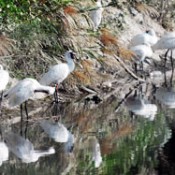
November 9, 2012 Ryukyu Shimpo
In the afternoon of November 8, six black-faced spoonbills, birds classified as an endangered species in the Red Data Book of the Ministry of the Environment, rested their wings on a pond known as Sankaku-Ike in the Yone district of Tomigusuku. According to bird-watchers, two of them stayed at the pond and were flying back and forth between Yone and the Awase tidal. These four birds are the first to fly to Okinawa this winter. Among them was a bird with a J15 tag on its foot, indicating that it also flew in last year.
In recent years more than ten black-faced spoonbills have flown in to the same pond, and it is expected that that number will increase in future.
(English translation by T&CT, Mark Ealey)
Go to Japanese

Go To Video
November 9, 2012 Kenyu Uchima of Ryukyu Shimpo
On November 8, a spokesperson of the headquarters of the U.S. Forces Japan (UFJ) reported that the U.S. military does not currently confirm whether or not its personnel are abiding by a nighttime curfew. The UFJ has placed a curfew on all their military personnel in Japan following the alleged rape of a woman by two U.S. sailors in October. In response to the question from the Ryukyu Shimpo, a spokesperson of the headquarters replied that the military forces educate their personnel, but do not go any further than putting the curfew in place and instructing the personnel to abide by it.
On November 5, the Ryukyu Shimpo asked UFJ headquarters whether or not the personnel stay in the U.S. military facilities or their homes outside of the facilities during the curfew hours of 11:00pm to 5:00am, and about the effectiveness of putting such a curfew in place.
In response, a spokesperson of the UFJ Public Affairs Office stated that the curfew was initiated under the Uniform Code of Military Justice, and those who violate it will be punished. Also the spokesperson said that headquarters try to make sure that the personnel will abide by the code of conduct, and strictly implement its policies, explaining they regularly educate personnel to abide by the curfew.
The spokesperson also explained that in addition to meetings and training sessions the headquarters provide their personnel with information on the curfew by means of printed publications in the U.S. military bases, and Social Networking Services, emphasizing that the UFJ seeks to make the curfew effective through education. However, they did not state how they ascertain whether or not the personnel abide by the curfew.
Following the alleged rape of a woman in the central region of the main island of Okinawa on October 16 by two U.S. military personnel, the U.S. Ambassador to Japan, John Roos and the Commander of the UFJ, Salvatore Angelella announced on October 19 that the UFJ would implement preventive measures such as a nighttime curfew on all their military personnel in Japan. Those measures include retraining of personnel and civilian employees with regard to core values and a review of the liberty card policy that regulates activities by the personnel in Japan outside their hours of work.
Despite these measures, a member of the U.S. Air Force personnel trespassed and assaulted a teenage boy in Yomitan during the curfew hours on November 2. Okinawan people are critical of the effectiveness of the supposed preventive measures.
In response to an inquiry from a representative of the Okinawa branch of the Komeito on November 5, Kenichi Murata, the head of the Okinawa Liaison Office of the Ministry of Foreign Affairs of Japan, said, “We are discussing how to check if personnel are not back in the U.S. military facilities or their homes during the period specified by the curfew.”
(English translation by T&CT, Mark Ealey)
Go to Japanese
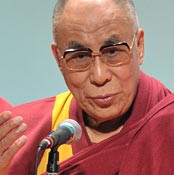
November 12, 2012 Ryukyu Shimpo
On November 11, at the Budokan in Naha, the supreme leader of Tibetan Buddhism, the 14th Dalai Lama gave a public talk on “The Strength to Overcome Difficulties and Talk to the Future Younger Generation.” It was attended by about 3500 people, including 645 high school and junior high school students who came free of charge. During his talk, he reflected on the 20th century as a century of violence and bloodshed, in which over 200 million people died as a result of war. “In order to make the 21st century a better era, we need to practice nonviolence, and we need to make an effort to achieve peace through dialogue which facilitates mutual respect and understanding.” He encouraged the younger generation to strive for a better and brighter future.
The Dalai Lama said, “The past only lives in our memories and it is no use worrying about what has already happened. The future depends on what’s happening now.” He also mentioned the destructive emotions, such as anger, hatred, jealousy and fear, which create a barrier between “us” and “them,” and that self-centered thinking originates from that barrier. “When we wish for other people to be happy and take responsibility for that, those destructive emotions will be transformed.” This was his second visit in Okinawa after the first in 2009. On the same day, he also visited Konpaku-no-To Memorial, the site of a Bodhi Tree as well as Himeyuri-no-To and the Himeyuri Peace Museum in Itoman.
(English translation by T&CT, Kyoko Tadaoka and Mark Ealey)
Go to Japanese

Go To Video
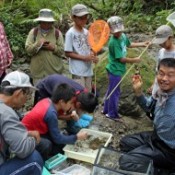
November 7, 2012 Ryukyu Shimpo
On October 27 and 28, the Okuma River Protection Fund, a non-profit organization, held the fourth nature observation tour at Okuma River in Kunigami. The tour started in May this year and received support grants from the Okinawa Kaiho Bank Environment Fund. Fumiyasu Sato, the director of the Kumejima Firefly Museum told children about the rich biodiversity of the water creatures in Okuma River. He called for people to protect the Okuma River because it will be important if the Yambaru forests in the northern part of Okinawa are designated as a world heritage in the future.
Sato explained that in the 90s when the road through the forest in the Yambaru area of Okunirindo was constructed, red soil ran off into the Okuma River, which decreased the number of creatures living in it. The river has been recovering in the last few decades due to the rain draining the soil out into the ocean. However, the red soil flowing out from the river in turn pollutes the sea, and that is a problem. He expects that it will take one or two centuries to clean up the ocean.
In the tour, they discovered the dragonfly larvae of Chlorogomphus brunneus brunneus oguma and Chlorogomphus okinawensis, an endangered species only found on the main island of Okinawa. Sato said, “There is an abundance of food for these dragonflies here. I hope that many people will come to know that Okinawa has these rare dragonflies.”
Takashi Nagamine, from Urasoe, participated with his child, said, “It was even more fun for me as an adult. I didn’t know there are so many kinds of creatures in the river.”
(English translation by T&CT, Lima Tokumori and Mark Ealey)
Go to Japanese

November 5, 2012 Ryukyu Shimpo
On November 1, the mascot character cookie called Pikarya, designed to look like the Iriomote yamaneko (wildcat), was launched. The town hopes that it will become a new souvenir.
Yuru-Kyara is an original mascot character used to advertise products or places.
Pikarya has been popular in Taketomi performing his special moya (kachashi dance) at local events. Pikarya will also participate in the Yuru-Kyara (mascot character) grand prix 2012 and compete with other mascot characters from across Japan.
The cookie is released as the fourth Pikarya product following the Pikarya mobile phone strap, badge, and facecloth.
The Town Tourist Association and Yaeyama-Nanpudo cookie shop collaborated to produce the cookie. The face and body of Pikarya are printed on the butter-flavored cookie.
It costs 1050 yen, inclusive of tax, for a box of twenty-four cookies. It is only available in souvenir stores in Ishigaki, Taketomi, and other Yaeyama Islands.
Producing the Pikarya cookie will help to lift people in Japan and to promote Taketomi. Mayor Eicho Kawamitsu commented, “The cookie tastes great, but the task at hand is how to market it. From our standpoint, we really hope that it will become one of the town’s symbolic souvenirs.
(English translation by T&CT, Hitomi Shinzato and Mark Ealey)
Go to Japanese
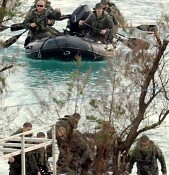
November 6, 2012 Ryukyu Shimpo
On November 5, U.S.-Japan biennial joint-bilateral field training exercise involving the Japanese Self-Defense Forces (SDF) and United States military started in Okinawa. Eight naval vessels, including three U.S. ships such as the Bonhomme Richard, a Wasp-class amphibious assault ship based at Sasebo Naval Station in Nagasaki Prefecture, and the Aegis-class destroyer of the Maritime Self-Defense Force, Chokai, gathered at the U.S. Navy White Beach Port Facility located in the Katsuren district of Uruma.
About 37400 SDF personnel and 10000 from the U.S. military will participate in the exercise. According to a spokesperson of the Joint Staff Office, the exercise will be conducted on the same scale as the previous one in 2010, which was one of the largest exercises to date.
Amphibious vehicles came and went from the Bonhomme Richard, and repeated landing on and leaving the shore at White Beach. U.S. military personnel in inflatable boats carried out landing drills and several SDF personnel in small craft landed on the beach from the ships.
The USS Denver, an Austin-class amphibious transport dock from the Sasebo base, which appeared to be participating in the exercise, was seen off the coast of the Henoko district of Nago during the course of the morning unloading 15 amphibious vehicles. The vehicles landed on the coast of Henoko, entering Camp Schwab.
(English translation by T&CT, Mark Ealey)
Go to Japanese

November 13, 2012 Ryukyu Shimpo
On November 12, in Okinawa, Tibetan spiritual leader the 14th Dalai Lama suggested how the Okinawan people, who suffer under the heavy burden of U.S. military presence, could take action. The Dalai Lama stated that the Okinawan people are well-educated and know about economic issues and human rights. He said that he would like them to look at the reality of their situation in a calm and collected manner rather than letting their emotions take control. He went on to say that they could use the written word in the likes of articles to convey the fact that discrimination does exist, and that their human rights have not been respected.
The 14th Dalai Lama talked with representatives of the various organizers of this trip to Okinawa to give a special lecture, including Junichi Tomita, the president of the Ryukyu Shimpo. In response to a question from Tomita, the Tibetan spiritual leader agreed that it is only natural for the people of Okinawa to think that it is discriminatory that 74 percent of exclusive-use U.S. military facilities in Japan are located in the small island of Okinawa.
The Dalai Lama pointed out that the people of Okinawa need to explain the human rights and equality issues to the academics in universities and research institutes in Japan.
Prior to this meeting, at 9:00am, the 14th Dalai Lama held a press conference in a hotel in Yaese Town. With regard to the territorial dispute over the Senkaku Islands, known as Diaoyu in China, he said, “China needs Japan. Japan needs China. That is the reality. This is more important. To solve problems you must talk.”
(English translation by T&CT, Mark Ealey)
Go to Japanese

Go To Video
November 6, 2012 Ryukyu Shimpo
Kadena Police have identified a member of the U.S. military as the suspect in the case of trespassing and assault of a junior high school student in Yomitan on November 2. Police officers spoke to the 24 year-old man stationed at Kadena Air Base after he agreed to be questioned. Although the man said that he remembered going to the bar on the first floor of the building, he did not admit to the other acts, stating that he was too drunk at the time to remember what happened after he got there. The police don’t intend to arrest the man nor request that he be handed over by the American authorities because he is in U.S. military custody, and is not suspected of running away or destroying evidence. In addition, the incident does not fall under the category of a heinous crime. If it did, in keeping with the amended approach to application of the Status of Forces Agreement, the Okinawan police would be able request the handing over of the suspect prior to indictment.
The police will continue questioning the man as long as he agrees to meet them, and as soon as charges are confirmed, they will submit a report regarding his being suspected of trespass, assault and damage to property. They also plan to seize the clothes the man was wearing at the time of the incident. Unless a suspect is badly injured, the police would very likely arrest a person suspected of committing this type of crime. If he were not a member of the U.S. military in Okinawa they would be able to arrest the man after his recovery as a result of the confirmation of his being the suspect. A police spokesperson stated, “The U.S. military is cooperating with our investigations into this case, and the man is answering our questions.” Be that as it may, the Okinawan people strongly oppose the police stance of not intending to arrest the man after his recovery, and not to request that he be handed over.
It seems that the man said that he lived outside of the base, and had been drinking at the bar before the incident, and then went drinking at a number of other establishments. He went back to the bar alone and drank beer and whisky. According to investigators, the man stated that he would like to apologize if the allegations are true, and that he wants to remember what happened. The police spokesperson reported that the man appeared to know about the nighttime curfew. It is reported that investigators questioned the man about the incident at a police facility.
The police confirmed that the man acknowledged that he went to the bar on the first floor of the building in question. The statements of the victim, witnesses and the situation in which the man was found at the scene, enabled investigators to confirm him as the suspect because there were no other foreigners in the building when the incident occurred. His physical appearance and clothes also matched what the victim and witnesses described. The man suffered broken ribs and a punctured lung in the fall, but it is reported that he has recovered to the extent of being able to slowly walk and be capable of answering questions. The man is scheduled to be asked further questions on November 6 and to receive medical treatment again on November 7.
(English translation by T&CT, Mark Ealey)
Go to Japanese












 Webcam(Kokusai Street)
Webcam(Kokusai Street)


